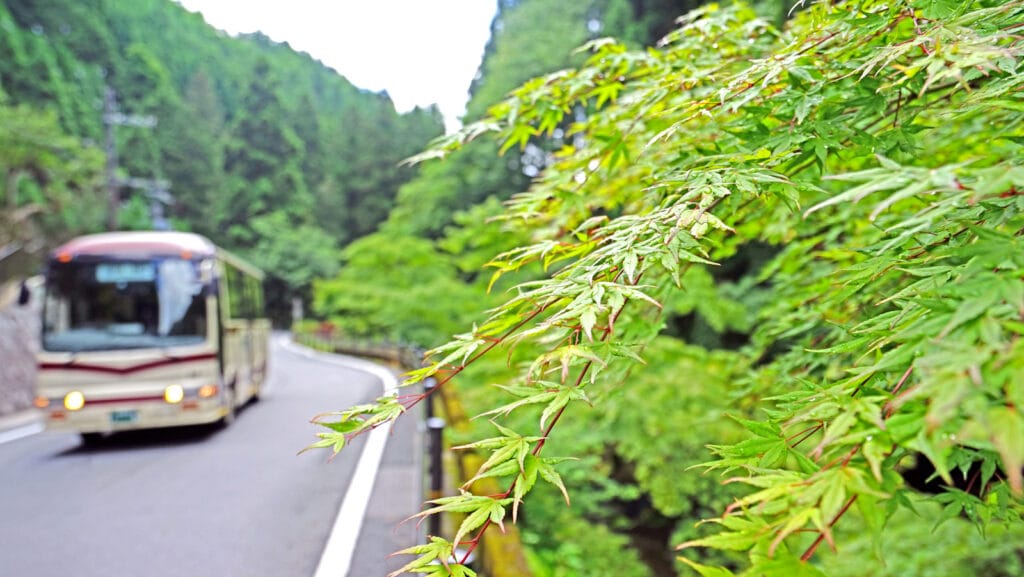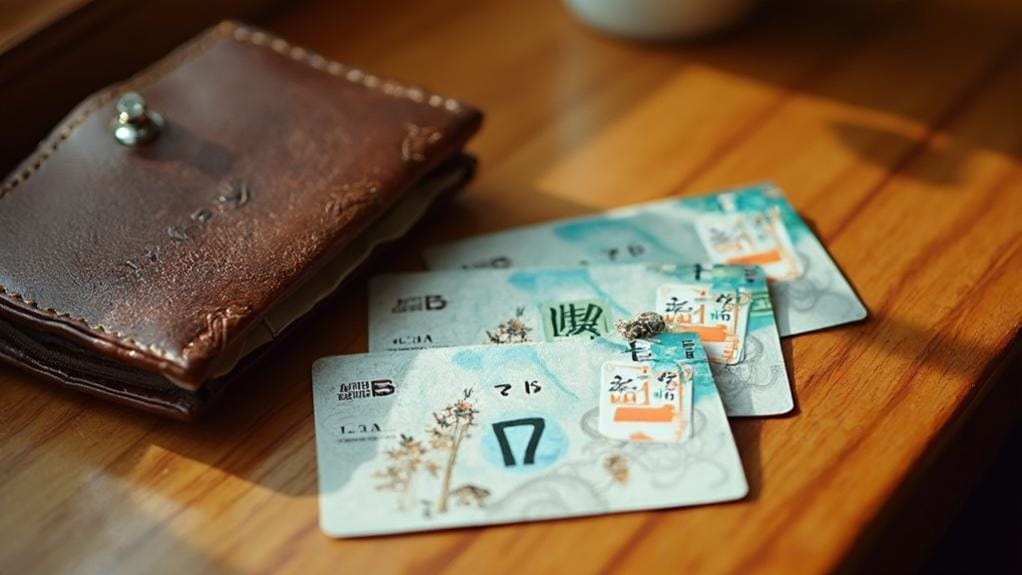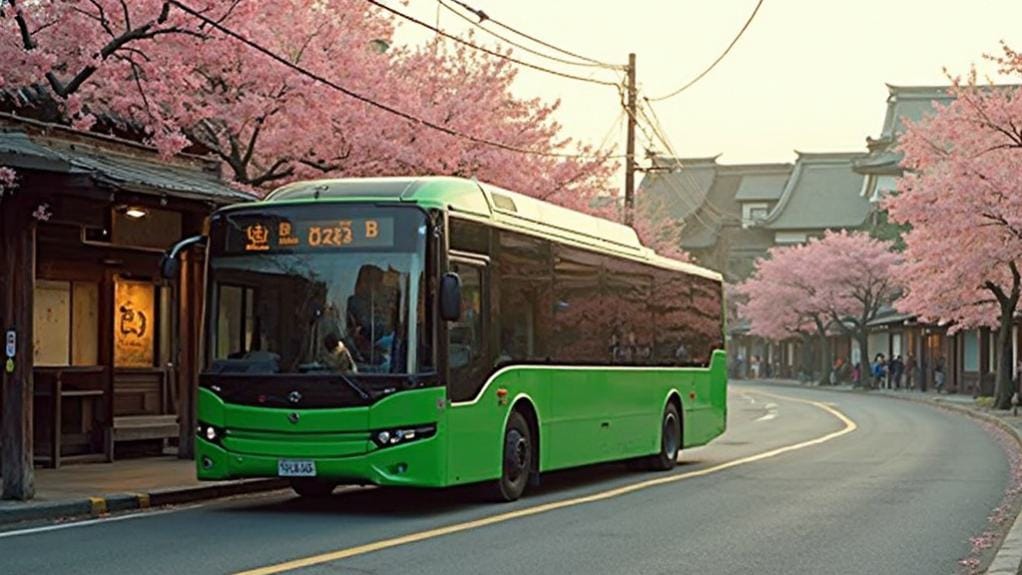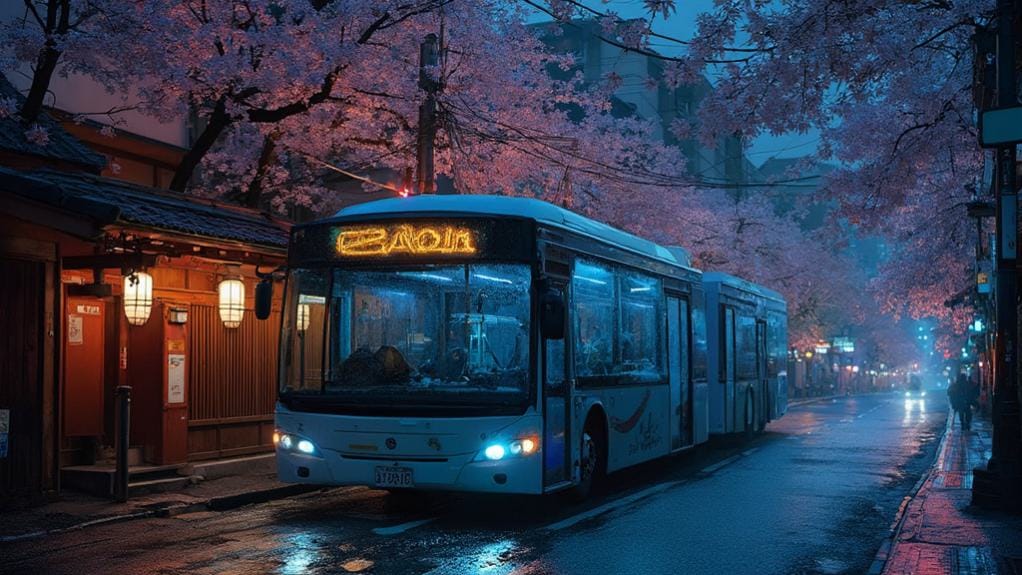I’ll help you navigate Kyoto’s extensive bus network like a local. The city offers several bus types: fixed-route city buses (green and cream), tourist-friendly Raku buses with multilingual announcements, and specialized night services.
You’ll want to grab an IC card (SUICA or ICOCA) or a cost-effective Day Pass (¥700) for easy boarding through the rear doors.
For the smoothest experience, use the Arukumachi KYOTO app for real-time arrivals, and remember to board at the back, exit at the front.
Peak hours (7-9 AM, 4-7 PM) can get crowded, so plan accordingly.
There’s much more to mastering Kyoto’s buses than meets the eye.
Understanding Kyoto’s Bus Types
Kyoto’s extensive bus network consists of three main types of services to meet different travel needs.
Let me guide you through each one: Fixed route buses, operated by Kyoto City Bus and Kyoto Bus, form the backbone of the system, with their distinctive green or cream-colored vehicles serving both central and outlying areas.
For a more tourist-friendly experience, you’ll find the colorful Raku Bus and the eye-catching SKY HOP BUS Kyoto, which whisk visitors between major attractions with multilingual announcements.
I particularly recommend the SKY HOP’s double-decker experience for a unique perspective of the city’s ancient streets.
Finally, there are specialized services like the Yoru Bus for nighttime travel and the Kinukake-no-Michi route, which connects you to stunning World Heritage Sites like Kinkaku-ji Temple.
Unlike Osaka’s subway system, which operates underground, Kyoto’s buses give you a street-level view of the city’s cultural heritage.
The cost-effective IC cards make it convenient to hop between different bus routes while exploring the city’s cultural landmarks.
Navigating Bus Routes and Stops

Mastering Kyoto’s bus system comes down to understanding a few key navigation basics.
I’ve found that using the Arukumachi KYOTO Route Planner is like having a local guide in your pocket, showing you real-time arrivals and the fastest routes across the city.
You’ll want to pay special attention to the route numbers, particularly those in the 200s that circulate on main roads.
- Look for clearly marked bus stops with multilingual signs indicating routes and destinations
- Download the Arukumachi KYOTO app for GPS tracking and live arrival predictions
- Note that Kyoto City Bus primarily serves suburban areas, while Kyoto Bus covers tourist spots like Arashiyama
- Remember that night buses (Yoru Bus) operate on limited routes, mainly around Kawaramachi and Gion
With day passes offering unlimited travel and discounts at tourist spots, buses provide an economical way to explore the city.
Unlike Tokyo’s Metro system, which relies on underground trains, Kyoto’s buses offer above-ground transportation with scenic views of the city.
These tools and tips will help you navigate Kyoto’s extensive bus network with confidence, whether you’re heading to ancient temples or modern shopping districts.
Payment Options and Passes

When riding Kyoto’s buses, understanding your payment options helps you avoid hassles and save money.
You’ll find several convenient choices that’ll fit your travel style, from traditional cash payments to modern IC cards like SUICA or ICOCA that you simply tap when entering and exiting.
Similar to the subway fare system, buses offer straightforward payment methods that make travel efficient and stress-free.
If you’re planning a day of extensive sightseeing, I’d recommend grabbing a City Bus All-Day Pass for ¥700 – it pays for itself after just four trips.
For longer stays, consider the Kyoto Sightseeing Two-day Pass at ¥2,000, which throws in subway access and some sweet shopping discounts around the city.
You’ll want to keep in mind that if you’re paying cash, you’ll need exact change or use the change machine, which accepts coins and 1000 yen notes but won’t give change back.
The bus system is particularly accommodating for senior travelers with priority seating and clear English announcements at major tourist stops.
Peak Hours and Travel Times
Nearly every bus route in Kyoto experiences heavy crowding during two main rush hours: 7:00-9:00 in the morning and 16:00-19:00 in the late afternoon.
I’ve found that tourist seasons can turn these normally busy periods into sardine-can scenarios, especially during the breathtaking cherry blossom and autumn foliage seasons. Staying at budget hostels can help you save money while waiting for less crowded transit times.
For an authentic local experience, consider exploring downtown Kyoto’s gems while waiting out the busiest transit times.
To help you navigate Kyoto’s bus system like a pro, I’ve compiled these essential timing tips:
- Most buses run from 6:00 to 23:00, with the Night Bus taking over from 20:00 to 22:50
- Main tourist routes (100-102) and city center lines offer more frequent service
- Special weekend and holiday express buses provide extra convenience
- Traffic congestion can throw schedules off track, so I’d recommend adding 15-20 minutes to your planned travel time
If you’re seeking a less crowded ride, I’d suggest traveling between 10:00-15:00 when possible.
Smart Journey Planning Tips

Successful navigation through Kyoto’s bus network comes down to smart pre-trip planning and real-time adaptability.
I’ll share my tried-and-true strategies to help you glide through the city like a local, avoiding common tourist pitfalls.
| Time of Day | Best Planning Tool | Key Strategy |
|---|---|---|
| Morning | Arukumachi App | Check traffic predictions |
| Afternoon | Google Maps | Compare route alternatives |
| Evening | Bus Route Map | Note night bus options |
Before you head out, I recommend downloading the Arukumachi KYOTO app – it’s been my lifesaver for real-time updates.
Consider grabbing a one-day bus pass if you’ll make more than three trips; it’ll save you both money and the hassle of counting change.
For tourist hotspots, I’ve found the 100 and 206 routes particularly useful, especially when combined with subway connections.
Many bus routes conveniently connect to Kyoto Station hub, making it an ideal starting point for your city exploration.
Just like Japanese airports, using clear signage throughout the bus system makes navigation significantly easier for international visitors.
Bus Etiquette for Tourists
Three key aspects of Japanese bus etiquette set it apart from Western norms: the distinct boarding process, precise payment methods, and mindful passenger behavior.
When you’re exploring Kyoto by bus, I’ll help you navigate these cultural expectations like a local.
You’ll need to enter through the rear door and exit at the front, maintaining a graceful flow that’s characteristic of Japanese efficiency. Just as with proper table manners, the emphasis is on maintaining harmony and consideration for others.
- Take a numbered ticket when boarding non-flat fare routes – it’s your key to calculating the correct fare
- Keep conversations whisper-quiet, and switch your phone to silent mode
- Consider priority seating sacred space for elderly, disabled, or passengers with infants
- Handle your belongings mindfully, keeping them close without inconveniencing others
Remember to carry smaller bills, as you can’t break anything larger than ¥1,000 on the bus.
First-time visitors to Japan often find these etiquette rules surprisingly different from their home countries.
Night Bus Services Guide

Kyoto’s night bus network provides essential late-evening transportation from popular entertainment districts like Kawaramachi and Gion to Kyoto Station.
You’ll find two main routes that’ll get you home safely: the Kawaramachi Yoru Bus and the Gion Yoru Bus, each serving specific areas during different time slots.
| Route Name | Operating Hours | Fare |
|---|---|---|
| Kawaramachi Yoru Bus | 22:00-22:50 | ¥230 |
| Gion Yoru Bus | 20:00-21:30 | ¥230 |
I recommend grabbing an IC card or one-day pass to make your nighttime travels smoother.
You’ll only be able to board at designated Yoru Bus stops, so keep an eye out for the clearly marked stations along the routes.
Whether you’re wrapping up a late dinner in Gion or finishing some shopping in Kawaramachi, these night buses guarantee you won’t get stranded.
Similar to Osaka’s public transit system, Kyoto’s night buses are designed to help tourists and locals navigate the city efficiently after dark.
Just as with train bookings, planning your night bus journey in advance ensures a hassle-free experience.
Popular Tourist Routes
Thanks to its extensive network of bus routes, getting around to Kyoto’s most celebrated attractions is remarkably straightforward.
I’ll help you navigate the best tourist-focused options that’ll make your temple-hopping adventures a breeze.
You can choose between regular fixed-route buses for budget travel, or opt for specialized sightseeing buses that include guided experiences and admission fees.
Many travelers start their journey in the historic Higashiyama District, known for its preserved traditional architecture and winding stone-paved streets.
For those seeking comfort before exploration, the Granvia Hotel offers direct access to Kyoto Station’s transportation hub.
- The new Limited Express EX100 and EX101 routes offer a fast-track to popular spots like Kiyomizu-dera and Ginkakuji.
- Fixed-route buses run every 10-15 minutes and cost just 230 yen per ride.
- Hop On Hop Off passes give you unlimited 24-hour access to 13 central locations.
- Sightseeing buses include expert guides and seasonal routes for unique experiences.
I’d particularly recommend the OKOSHI Bus for first-timers – it’s designed specifically for efficient sightseeing and covers all the major landmarks.
Money Saving Travel Strategies

While exploring Kyoto’s attractions by bus is convenient, smart travelers can greatly reduce their transportation costs through several money-saving options.
Remember to practice Japanese bus etiquette by bowing slightly to the driver and exiting through the rear door.
I’ve found the All-Day Bus Pass at 500 yen to be an absolute steal, especially if you’re planning to hop between temples and shrines.
For even more flexibility, I’d recommend grabbing the Subway & Bus 1-Day Pass for 1,100 yen, which I’ve used countless times to zigzag across the city without watching the meter tick up.
If you’re tech-savvy like me, you’ll love the ICOCA card – it’s like having a magic wand that whisks you through the gates without fumbling for change.
Consider exploring domestic flight options to combine your Kyoto bus experience with visits to other Japanese cities.
Don’t forget to check out those combination tickets that bundle transport with attraction entries; they’re real money-savers that’ll keep your wallet happy.
Essential Bus Riding Rules
Mastering Kyoto’s bus etiquette starts with knowing the basic boarding rules. I’ll let you in on a secret: locals take their bus manners seriously, and you’ll want to follow suit to blend in seamlessly.
You’ll need to board through the middle door and exit through the front, keeping your payment ready as you approach your stop.
Much like shrine etiquette rules, respectful behavior is deeply embedded in Japanese culture and public transportation. While Japan is a safe destination, being mindful of your surroundings helps ensure a smooth journey.
- Always offer priority seats to elderly passengers, those with disabilities, or parents with infants
- Keep conversations whisper-quiet and avoid phone calls entirely
- Hold your bags close to avoid bumping other passengers
- Never eat or drink while riding – save those snacks for later
Remember to have exact change (230 yen for adults) or a charged IC card ready.
If you’re planning multiple stops, I’d strongly recommend grabbing a day pass to save both money and hassle.



